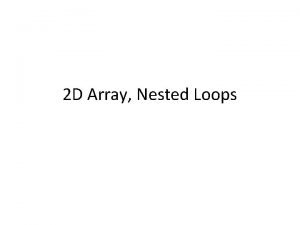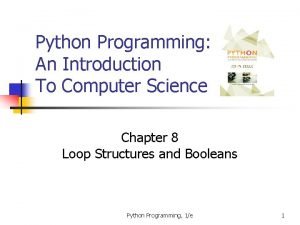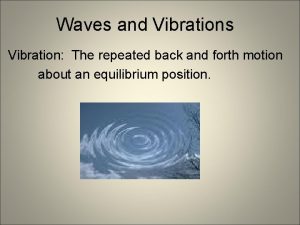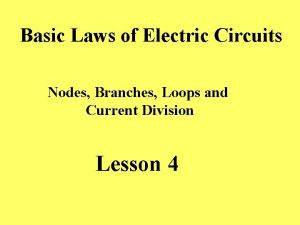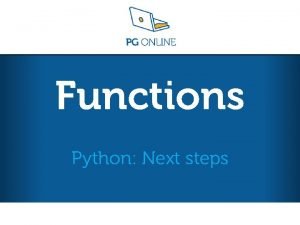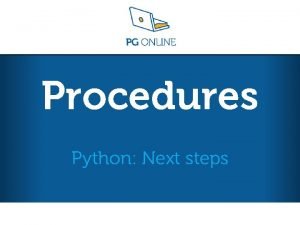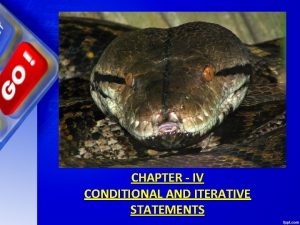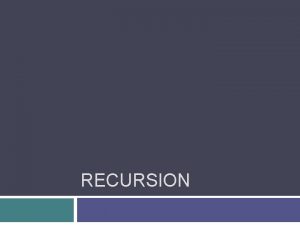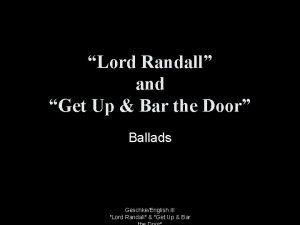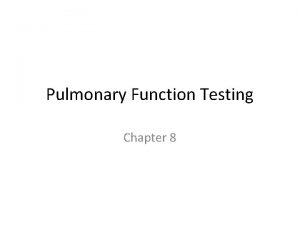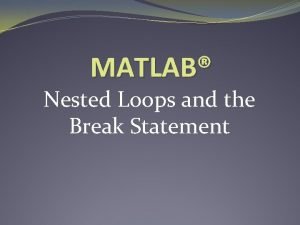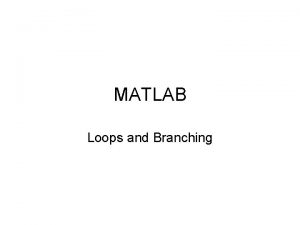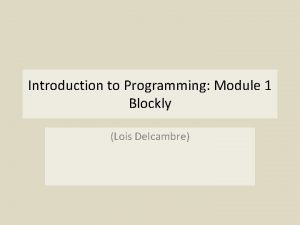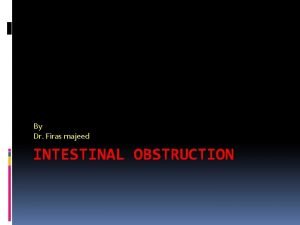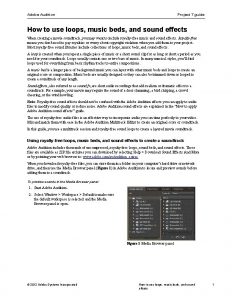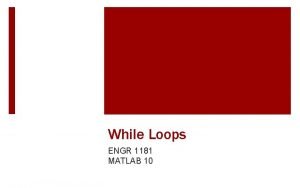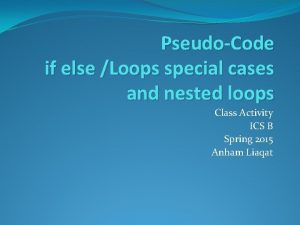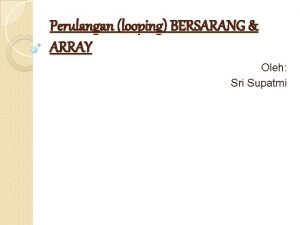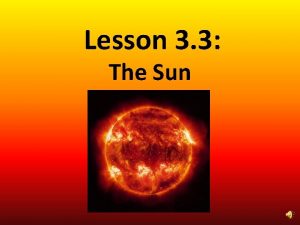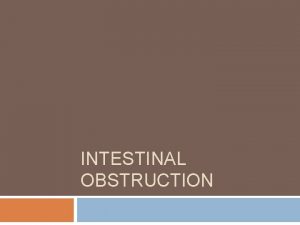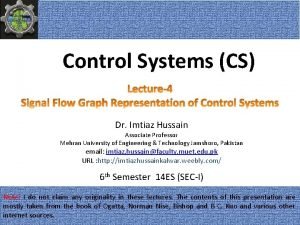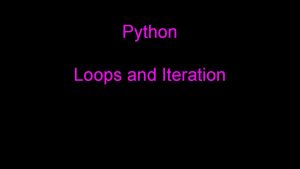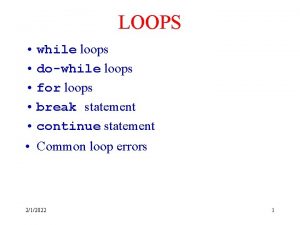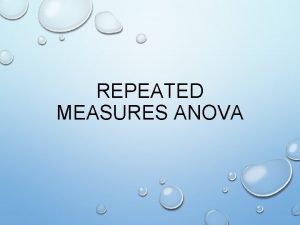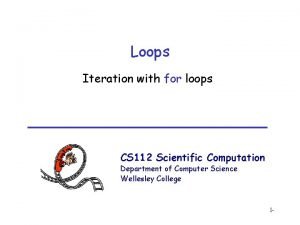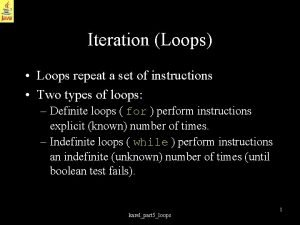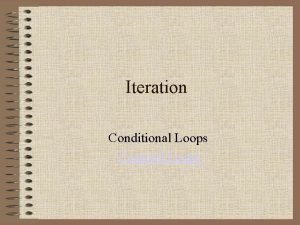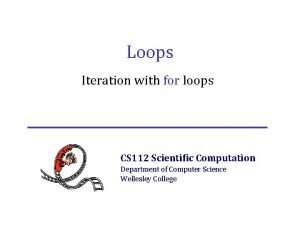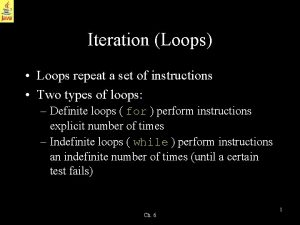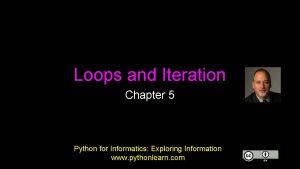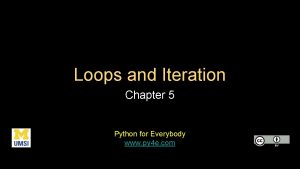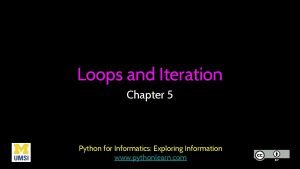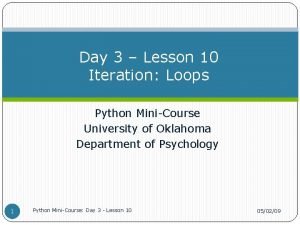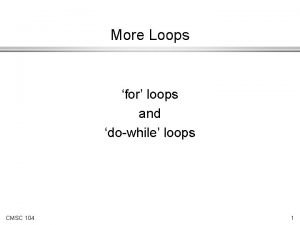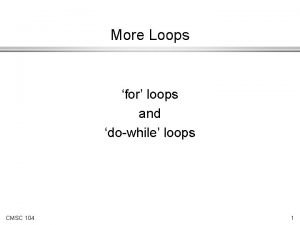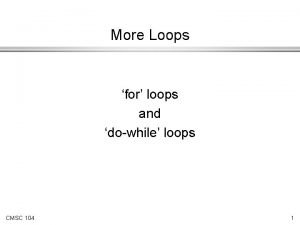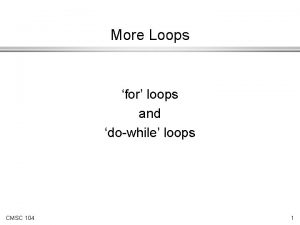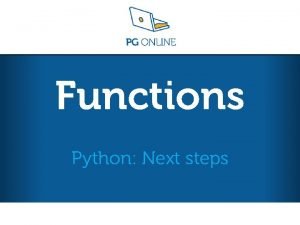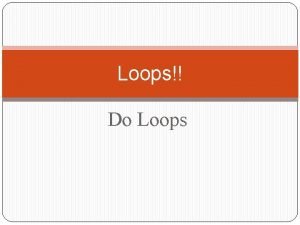Python Loops and Iteration Repeated Steps n5 No









![No while True: line = raw_input('> ’) if line[0] == '#' : continue if No while True: line = raw_input('> ’) if line[0] == '#' : continue if](https://slidetodoc.com/presentation_image_h/0d111683a3e6a138d4b6c2f23eedb820/image-10.jpg)


![A Simple Definite Loop for i in [5, 4, 3, 2, 1] : print A Simple Definite Loop for i in [5, 4, 3, 2, 1] : print](https://slidetodoc.com/presentation_image_h/0d111683a3e6a138d4b6c2f23eedb820/image-13.jpg)
![A Definite Loop with Strings friends = ['Joseph', 'Glenn', 'Sally'] for friend in friends A Definite Loop with Strings friends = ['Joseph', 'Glenn', 'Sally'] for friend in friends](https://slidetodoc.com/presentation_image_h/0d111683a3e6a138d4b6c2f23eedb820/image-14.jpg)



















- Slides: 33

Python - Loops and Iteration

Repeated Steps n=5 No n>0? Yes print n n = n -1 print 'Blastoff' Program: Output: n=5 while n > 0 : print n n=n– 1 print 'Blastoff!' print n 5 4 3 2 1 Blastoff! 0 Loops (repeated steps) have iteration variables, which change each time through a loop. Often these iteration variables go through a sequence of numbers.

n=5 No Yes n>0? print 'Lather' print 'Rinse' An Infinite Loop n=5 while n > 0 : print 'Lather’ print 'Rinse' print 'Dry off!' What is wrong with this loop?

n=0 No Yes n>0? print 'Lather' print 'Rinse' Another Loop n=0 while n > 0 : print 'Lather’ print 'Rinse' print 'Dry off!' What does this loop do?

Breaking Out of a Loop -- The break statement ends the current loop and jumps to the statement immediately following the loop while True: line = raw_input('> ') if line == 'done' : break print line print 'Done!' > hello there > finished > done Done!

Breaking Out of a Loop -- The break statement ends the current loop and jumps to the statement immediately following the loop while True: line = raw_input('> ') if line == 'done' : break print line print 'Done!' > hello there > finished Finished > done Done!

while True: line = raw_input('> ') if line == 'done' : break print line print 'Done!' No True ? Yes. . break. . . print 'Done'

Finishing an Iteration with continue -- The continue statement ends the current iteration and jumps to the top of the loop and starts the next iteration while True: line = raw_input('> ') if line[0] == '#' : continue if line == 'done' : break print line print 'Done!' > hello there > # don't print this > print this! > done Done!

Finishing an Iteration with continue -- The continue statement ends the current iteration and jumps to the top of the loop and starts the next iteration while True: line = raw_input('> ') if line[0] == '#' : continue if line == 'done' : break print line print 'Done!' > hello there > # don't print this > print this! > done Done!
![No while True line rawinput if line0 continue if No while True: line = raw_input('> ’) if line[0] == '#' : continue if](https://slidetodoc.com/presentation_image_h/0d111683a3e6a138d4b6c2f23eedb820/image-10.jpg)
No while True: line = raw_input('> ’) if line[0] == '#' : continue if line == 'done' : break print line print 'Done!' True ? Yes. . continue. . . print 'Done'

Indefinite Loops -- While loops are called "indefinite loops" because they keep going until a logical condition becomes False -- The loops discussed so far are pretty easy to examine to see if they will terminate or if they will be "infinite loops“

Definite Loops -- Often there is a list of items in a file - effectively a finite set of things -- Write a loop to run for each of the items in a set using the Python for construct -- These loops are called "definite loops" because they execute an exact number of times -- "definite loops iterate through the members of a set"
![A Simple Definite Loop for i in 5 4 3 2 1 print A Simple Definite Loop for i in [5, 4, 3, 2, 1] : print](https://slidetodoc.com/presentation_image_h/0d111683a3e6a138d4b6c2f23eedb820/image-13.jpg)
A Simple Definite Loop for i in [5, 4, 3, 2, 1] : print i print 'Blastoff!' 5 4 3 2 1 Blastoff!
![A Definite Loop with Strings friends Joseph Glenn Sally for friend in friends A Definite Loop with Strings friends = ['Joseph', 'Glenn', 'Sally'] for friend in friends](https://slidetodoc.com/presentation_image_h/0d111683a3e6a138d4b6c2f23eedb820/image-14.jpg)
A Definite Loop with Strings friends = ['Joseph', 'Glenn', 'Sally'] for friend in friends : print 'Happy New Year: ', friend print 'Done!' Happy New Year: Joseph Happy New Year: Glenn Happy New Year: Sally Done!

Yes A Simple Definite Loop No Done? Move i ahead print i print 'Blast off!' for i in [5, 4, 3, 2, 1] : print i print 'Blastoff!' 5 4 3 2 1 Blastoff! Definite loops (for loops) have explicit iteration variables that change each time through a loop. These iteration variables move through the sequence or set.

Looking at In. . . -- The iteration variable “iterates” though the sequence (ordered set) -- The block (body) of code is executed once for each value in the sequence -- The iteration variable moves through all of the values in the sequence Iteration variable Five-element sequence for i in [5, 4, 3, 2, 1] : print i

Yes No Done? Move i ahead print i for i in [5, 4, 3, 2, 1] : print i -- The iteration variable “iterates” though the sequence (ordered set) -- The block (body) of code is executed once for each value in the sequence -- The iteration variable moves through all of the values in the sequence

i=5 Yes No print i Done? Move i ahead print i i=4 print i i=3 print i i=2 for i in [5, 4, 3, 2, 1] : print i i=1 print i

The Loop: What We Do in Loops Note: Even though these examples are simple, the patterns apply to all kinds of loops

Making “smart” loops Set some variables to initial values for thing in data: Look for something or do something to each entry separately, updating a variable. Look at the variables.

Looping through a Set print 'Before' for thing in [9, 41, 12, 3, 74, 15] : print thing print 'After' $ python basicloop. py Before 9 41 12 3 74 15 After

What is the Largest Number?

What is the Largest Number? 3 4 1 largest_so_far 1 2 9 -13 4174 7 4 1 5


Counting in a Loop $ python countloop. py Before 0 19 2 41 3 12 43 5 74 6 15 After 6 To count how many times we execute a loop we introduce a counter variable, which starts at 0 and we add one to it each time through the loop zork = 0 print 'Before', zork for thing in [9, 41, 12, 3, 74, 15] : zork = zork + 1 print zork, thing print 'After', zork

Summing in a Loop zork = 0 print 'Before', zork for thing in [9, 41, 12, 3, 74, 15] : zork = zork + thing print zork, thing print 'After', zork $ python countloop. py Before 0 99 50 41 62 12 65 3 139 74 15 After 154 To add up a value we encounter in a loop, we introduce a sum variable that starts at 0 and we add the value to the sum each time through the loop

Finding the Average in a Loop count = 0 sum = 0 print 'Before', count, sum for value in [9, 41, 12, 3, 74, 15] : count = count + 1 sum = sum + value print count, sum, value print 'After', count, sum / count $ python averageloop. py Before 0 0 199 2 50 41 3 62 12 4 65 3 5 139 74 6 154 15 After 6 154 25 An average just combines the counting and sum patterns and divides when the loop is done

Filtering in a Loop print 'Before’ for value in [9, 41, 12, 3, 74, 15] : if value > 20: print 'Large number', value print 'After' $ python search 1. py Before Large number 41 Large number 74 After We use an if statement in the loop to catch / filter the values we are looking for.

Search Using a Boolean Variable found = False print 'Before', found for value in [9, 41, 12, 3, 74, 15] : if value == 3 : found = True print found, value print 'After', found $ python search 1. py Before False 9 False 41 False 12 True 3 True 74 True 15 After True To search and know if a value was found - a variable starts at False and is set to True as soon as the value is found

What is the Smallest Number? 9 4 1 smallest_so_far 1 2 -1 3 7 4 1 5

What is the Smallest Number? 9 4 1 largest_so_far 1 2 3 None 9 3 7 4 1 5

Finding the smallest value smallest = None print 'Before’ for value in [9, 41, 12, 3, 74, 15] : if smallest is None : smallest = value elif value < smallest : smallest = value print smallest, value print 'After', smallest $ python smallest. py Before 99 9 41 9 12 33 3 74 3 15 After 3 Determine a smallest variable -- The first time through the loop smallest is None so the first value to be the smallest

The "is" and "is not" Operators smallest = None print 'Before’ for value in [3, 41, 12, 9, 74, 15] : if smallest is None : smallest = value elif value < smallest : smallest = value print smallest, value print 'After', smallest -- Python has an "is" operaror that can be used in logical expressions -- Implies 'is the same as' -- Similar to, but stronger than == -- 'is not' also is a logical operator
 Nested loops python
Nested loops python Nested loops python
Nested loops python Python sentinel loop
Python sentinel loop What is a repeated back-and-forth or up-and -down motion?
What is a repeated back-and-forth or up-and -down motion? While loops and if-else structures
While loops and if-else structures Branches of electricity
Branches of electricity Loops and graphics in small basic
Loops and graphics in small basic Which of the following is not an example of axial movement
Which of the following is not an example of axial movement Python next steps
Python next steps What is procedure in python
What is procedure in python Sequencing iteration and selection
Sequencing iteration and selection Conditional and iterative statements
Conditional and iterative statements Get sequence get another sequence pseudocode
Get sequence get another sequence pseudocode Replace recursion with iteration
Replace recursion with iteration Repeated percentage change questions and answers
Repeated percentage change questions and answers Conflict of get up and bar the door
Conflict of get up and bar the door Fef 200-1200
Fef 200-1200 Reddish loops of gas
Reddish loops of gas Matlab break statement
Matlab break statement Types of loops in matlab
Types of loops in matlab Lesson 13 bee nested loops
Lesson 13 bee nested loops Drilling fluid
Drilling fluid For loops matlab
For loops matlab Cakewalk loop construction
Cakewalk loop construction Myxodoema
Myxodoema Adobe audition loops
Adobe audition loops While loop matlab
While loop matlab If else pseudocode
If else pseudocode Is nested loops bad
Is nested loops bad Classification of duodenal atresia
Classification of duodenal atresia Reddish loops of gas that link parts of sunspot regions
Reddish loops of gas that link parts of sunspot regions Closed loop obstruction examples
Closed loop obstruction examples Forward path in signal flow graph
Forward path in signal flow graph Loops in tosca
Loops in tosca

